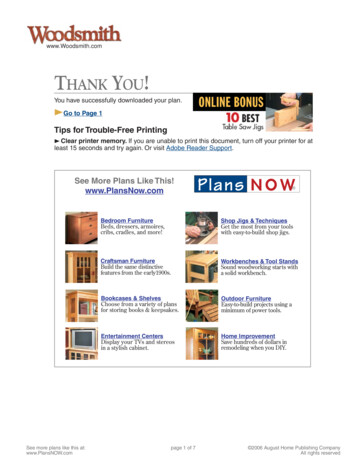
Transcription
www.Woodsmith.comTHANK YOU!You have successfully downloaded your plan. Go to Page 1Tips for Trouble-Free Printing Clear printer memory. If you are unable to print this document, turn off your printer for atleast 15 seconds and try again. Or visit Adobe Reader Support.See More Plans Like This!www.PlansNow.comSee more plans like this at:www.PlansNOW.comPlans N O W Bedroom FurnitureBeds, dressers, armoires,cribs, cradles, and more!Shop Jigs & TechniquesGet the most from your toolswith easy-to-build shop jigs.Craftsman FurnitureBuild the same distinctivefeatures from the early1900s.Workbenches & Tool StandsSound woodworking starts witha solid workbench.Bookcases & ShelvesChoose from a variety of plansfor storing books & keepsakes.Outdoor FurnitureEasy-to-build projects using aminimum of power tools.Entertainment CentersDisplay your TVs and stereosin a stylish cabinet.Home ImprovementSave hundreds of dollars inremodeling when you DIY.page 1 of 7 2006 August Home Publishing CompanyAll rights reserved
www.Woodsmith.com10 BESTTABLE SAW JIGSThe table saw is king in my shop. It sits right in themiddle where I can get at it easily. Whether it’s roughcutting a board to length or fine tuning a project'sjoinery, more than likely I'll go to the table saw. But whatreally makes my table saw so versatile are the shop-built“helpers” I’ve accumulated through the years. I'm not talk-ing about jigs that are difficult to build or time consumingto set up. Even the more involved jigs here can be builtin just a few hours.JUST A NOTE. Some of these accessories are designedand sized to fit my 10" contractor’s saw. But they can beadapted to fit just about any brand or size of table saw.1. PUSH BLOCKIt might seem like a pretty simple accessory, but I’ve found thatusing the right push block not only makes your work safer, it canalso improve the quality.The main purpose of a good push block is to keep your fingers faraway from the saw blade. And the first thing you’ll notice about thispush block, shown at work in the photo at right, is the comfortable“high mounted” handle. This is definitely a big plus in my book.But the best part is that you don’t have to sacrifice when it comesto control. The forward sweep of the handle allows you to put gooddownward pressure on the workpiece and achieve a steady, controlled feed. You’ll get a clean cut while keeping your hands safeand avoiding the risk of kickback.REPLACEABLE PARTS. Of course, a push block is going to get chewedup. That’s what they’re for. You sacrifice the push block to save yourfingers. So this model is designed with a business end that can beeasily replaced. When the body or the hardboard push cleat gettoo worn, just cut new ones and switch out the handle, see drawingbelow. And with the handle mounted “up above,” it will never betouched by the saw blade.1See more plans like this at:www.PlansNOW.coma.page 2 of 72 2006 August Home Publishing CompanyAll rights reserved
2. ADJUSTABLE MITER GAUGE FENCEI sometimes think that even the table saw manufacturers would concede that the miter gauges supplied withtheir saws are just a star ting point. That’s becauseevery one I’ve ever seen has holes in the face for mounting an auxiliar y fence.The small face of the gauge just doesn’t have enoughsurface to provide solid support for the workpiece. It’s easyto attach a short length of 3/4"-thick stock to the face of themiter gauge to solve the problem, but I wanted a little more.I needed a fence that would provide good support right upto the cut at different angles.ADJUSTABLE. That’s a pretty tall order. But the answer isthis adjustable miter gauge fence. As you can see in the drawingbelow, it uses a rabbeted cleat system that allows the fence to slidetoward or away from the blade depending on the angle of thecut. And just tightening a couple of screws locks the positionof the fence. This allows you to make your cuts with completecontrol of the workpiece.At times I’ll even slide the fence beyond the blade so that itfollows the workpiece through the blade and backs up the cut.And when the fence gets chewed up, it can easily be replaced.1a.b.3. OUTFEED ROLLERA good outfeed roller just takes the place of the friend youhave to cajole into helping you rip those long boards orpanels to width. So it makes life a little bit easier for bothyou and your friends.I’ve tried the commercial outfeed rollers, butSee more plans like this at:www.PlansNOW.comI think this shop-built modelhas them all beat.First, it’s cheap to build. As youcan see in the drawing, all youneed is some scrap lumber, a shortlength of PVC pipe, a dowel, andwoodscrews.But the big plus is in the waythe roller is supported. Most commercial outfeed rollers use a tripodsystem. This type has caused megrief on more than one occasion.They aren’t very stable and theyseem to tip or even fall over at justthe wrong time.But this outfeed roller is designed to be clampedfirmly to a sawhorse or other solid support, as in thephoto above. So once you set it up, it’ll stay put andallow you to focus on the task at hand.page 3 of 7 2006 August Home Publishing CompanyAll rights reserved
4. ZERO-CLEARANCE BLADE INSERTA zero-clearance blade insert for your saw may not seemlike an important item. But there are times when I wouldn’tbe without one on my saw.The advantage it provides is that it supports the underside of the workpiece right up to the edge of the cut. So it’smuch less likely that the saw blade will cause chipping. Itcan be a real lifesaver when you need a perfectly clean cutin expensive hardwood or plywood.When using a dado blade, a zero clearance inser t isessential. I often use a dado blade to cut dadoes, rabbets— you name it. And when I do, I’ll pop in an insert sizedto the width of the blade. With this arrangement, you havesolid support for a smooth, accurate cut.1SIMPLE PROCESS. You can make one of these plywood inserts inshort order. The drawings below show how to use the standard insert, first as a pattern, then as a routing template. Thisworks great. Fig. a shows how to complete the job.a.2a.5. SLIP-0N FENCEOnce you build this auxiliary rip fence andslip it in place over your standard fence youmight end up not taking it off very often. It’sreally that handy.PLYWOOD CONSTRUCTION. As you see in thedrawings below, it’s just a few scraps of plywood and woodscrews with a little bit of dadoblade joinery. Size it to fit over your standardfence and you’re in business.EASY TO USE. The first big plus is how easily it slips into place onthe saw. There are no screws or clamps to deal with.TWO SIDES. If you take a look at the photos above, you’ll see thatthis auxiliary rip fence does double duty. When you want to use1See more plans like this at:www.PlansNOW.comthe dado blade to cut a rabbet, bury it in the short face of thefence. You’ll still have plenty of room to use a push block.But there are times when the extra support of a tall fence iswhat’s called for. So just flip the fence, and go to work with oneless thing to worry about.a.page 4 of 72 2006 August Home Publishing CompanyAll rights reserved
6. STRAIGHT-LINE RIP JIGIt seems that no matter how particular you are when buyinglumber, you always end up with a few boards that are socrooked they look like they were meant to be chair rockers.And sometimes even the best stock bought “in the rough”doesn’t have a good, straight edge to work from.SOLUTION. So how do you dimension these boards into usablestock? Well the solution is the easy-to-use straight-line rip jigshown in the photo at right.This jig is about as simple to put together as any you’ll find.Nothing but a couple of lengths1of plywood and a few inexpensive toggle clamps. But it canreap big rewards salvagingsome of that crooked lumber.Just set the board on thestraightedge, clamp it downwith the quick-action clamps,and run it through your saw.a.7. ADJUSTABLE FEATHERBOARDThere are times when you’re working at the table saw that athird hand would make life easier. Well, this adjustable featherboard isn’t quite a third hand, but it's the next best thing.SELF CLAMPING. A featherboard uses lots of flexible “fingers” toapply steady pressure. But to do its job, it has to stay put. Andon a table saw, clamping a featherboard isn’t easy.But not so with this model. It’s designed to slip into the mitergauge slot of the saw and lock down with a twist of a wingknob. It can be positioned anywhere along the slot and thenadjusted in or out to apply just the right amount of pressure.WHEN. I like to use it when ripping stock to size. With steadypressure, there’s less chance of the board wandering awayfrom the fence.THE RUNNER . The key par t is the slotted expandablerunner. A look at Fig. 1a shows how turning the wing1knob forces the headof the bolt into the slotand locks it down.2a.a.b.See more plans like this at:www.PlansNOW.compage 5 of 7 2006 August Home Publishing CompanyAll rights reserved
8. CUT-OFF SLEDSometimes, after you buy a new tool or build an accessory, youwonder how you ever got along without it. And that’s the case withthis cut-off sled. This accessory is really a pretty simple idea, butonce you build it, you’ll find yourself using it time after time.Think of it as just a really big miter gauge for working with wideboards and panels. A standard miter gauge with an auxiliary fenceworks great for cutting cabinet facings or door parts to length,but when it comes to crosscuting an 18"-wide plywood panel or asmall tabletop you need a bit more control. And that’s what thissled will give you.THE WHOLE SAW. As you can see, it’s designed to use both mitergauge slots and slide on most of the saw table. And where yourmiter gauge might have an 18" auxiliary fence, this cut-off sledhas a 48" long fence.It might look a little awkward to feed through the saw. But justwipe a thin coat of wax on the runners and the base and the sledglides easily across the table.You’ll also find that you get a more accurate cut using the sled.Since all the pieces — fence, bed and workpiece are movingacross the saw together, there’s almost no chance of the workpiece shifting or you losing your grip.USER NOTE. When I make a cut, I always stand toward the left side ofthe sled and push with my right hand on the left top of the fence asyou see in the photo above. My left hand is free to hold the workpieceflat and tightly against the fence. This makes control of the workpieceeasier and the feed will be smoother.12b.a.a.SAFETY SHIELDAt the end of the cut, the saw blade passesthrough the rear fence. This was a bitof a concern to me. So to minimize anychance of an accident, I added a bladeguard to the rear fence. It’s nothing morethan a plywood side guard that supports asmall Plexiglas shield. It still allows you tosee the workpiece and the saw blade, buthelps protect you from possible contact.See more plans like this at:www.PlansNOW.compage 6 of 7 2006 August Home Publishing CompanyAll rights reserved
9. TENONING JIGA tenoning jig is usually one of the standardadd-on accessories offered by table saw manufacturers. But these are usually really heavyduty models that are going to cost a prettyfair amount of money. So I opted to build myown version with just a few bucks worth ofmaterial and a little investment of time. And Ithink it works just as well.BUILD IT. Just take a look at the drawings belowand you’ll see how easy this jig is to build. Asyou can see in the photo at right, it just slipsover and slides along the rip fence of the saw.So the adjustment mechanism on the rip fencemakes an easy job of lining up the cut.USE IT. The question you might ask is whybother with a tenoning jig when a dadoblade will do the job?Well, of course you can use this jig toquickly cut the cheeks of a tenon, butthat’s not all it’ll do.Whenever I cut an exposed bridle jointor a half-lap I turn to this jig to create thesmooth cheeks and tight fit that I want.For a bridle joint I’ll use the tenon jigto first cut the centered “groove” of thejoint. I then turn around and reset thejig to cut an accurate tenon to fit. Andboth halves of the joint end up perfectlysmooth, without the score marks or stepsleft by a dado blade.1a.10. DEDICATED MITER SLEDTo a seasoned woodworker, no jointmakes a better impression than a clean,tight-fitting miter. It says “Hey, this personknows his stuff.”The catch is that cutting an accurate45 miter can often be a matter of trialand er ror, with a little luck. But thisdedicated miter sled can make accuratemiters a sure thing.Since you’re only worried about oneangle — a perfect 45 — that’s all this1See more plans like this at:www.PlansNOW.comsled does. Once it’s set up, you’ll get thesame cut time after time.ON THE MARK. And the added bonus is thatyou’ll know right where the cut will fall.As you can see below, you can just lineup your mark with the edge of the sled.There’s no guesswork involved.And to make the matching miter there’sno need to flip the piece over and cut fromthe opposite side. Just move the sled to theopposite miter slot. W2a.page 7 of 7 2006 August Home Publishing CompanyAll rights reserved
the dado blade to cut a rabbet, bury it in the short face of the fence. You’ll still have plenty of room to use a push block. But there are times when the extra support of a tall fence is what’s called for. So just flip the fence, an











